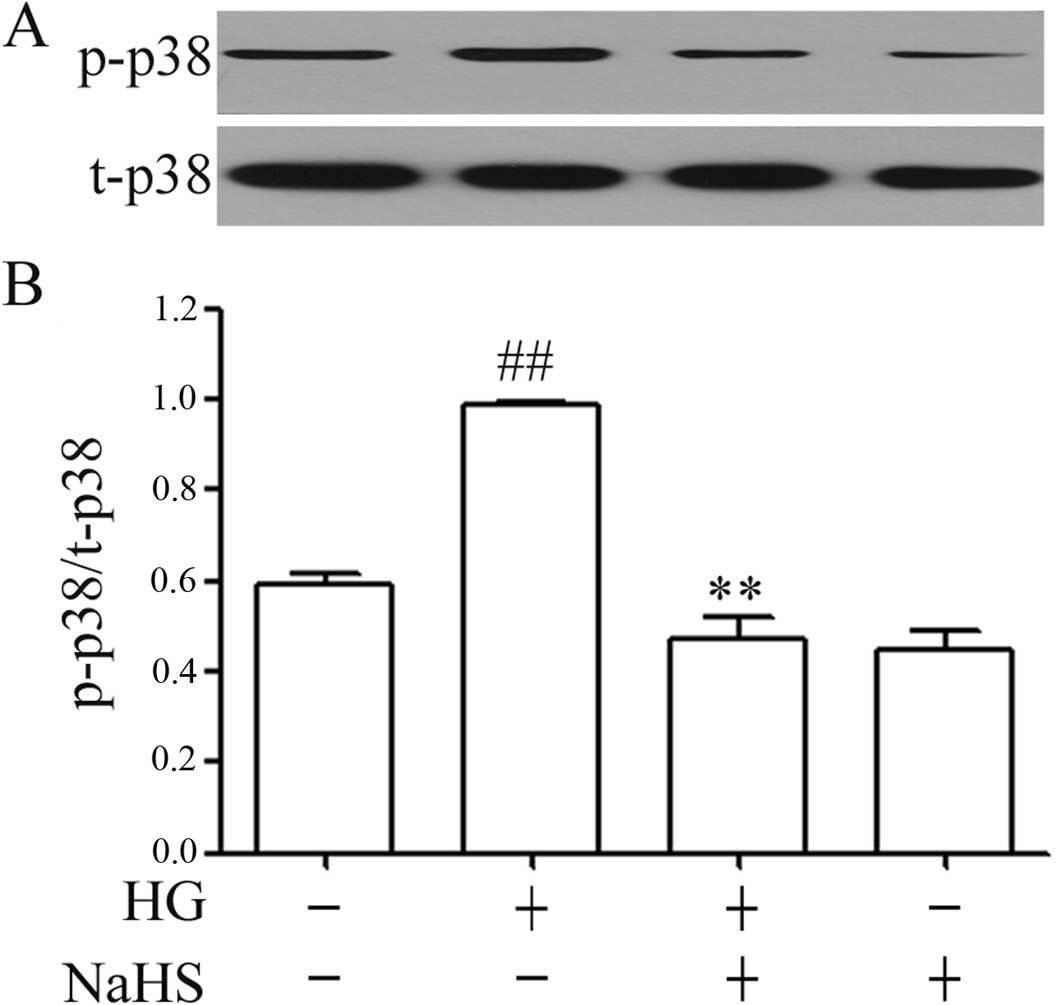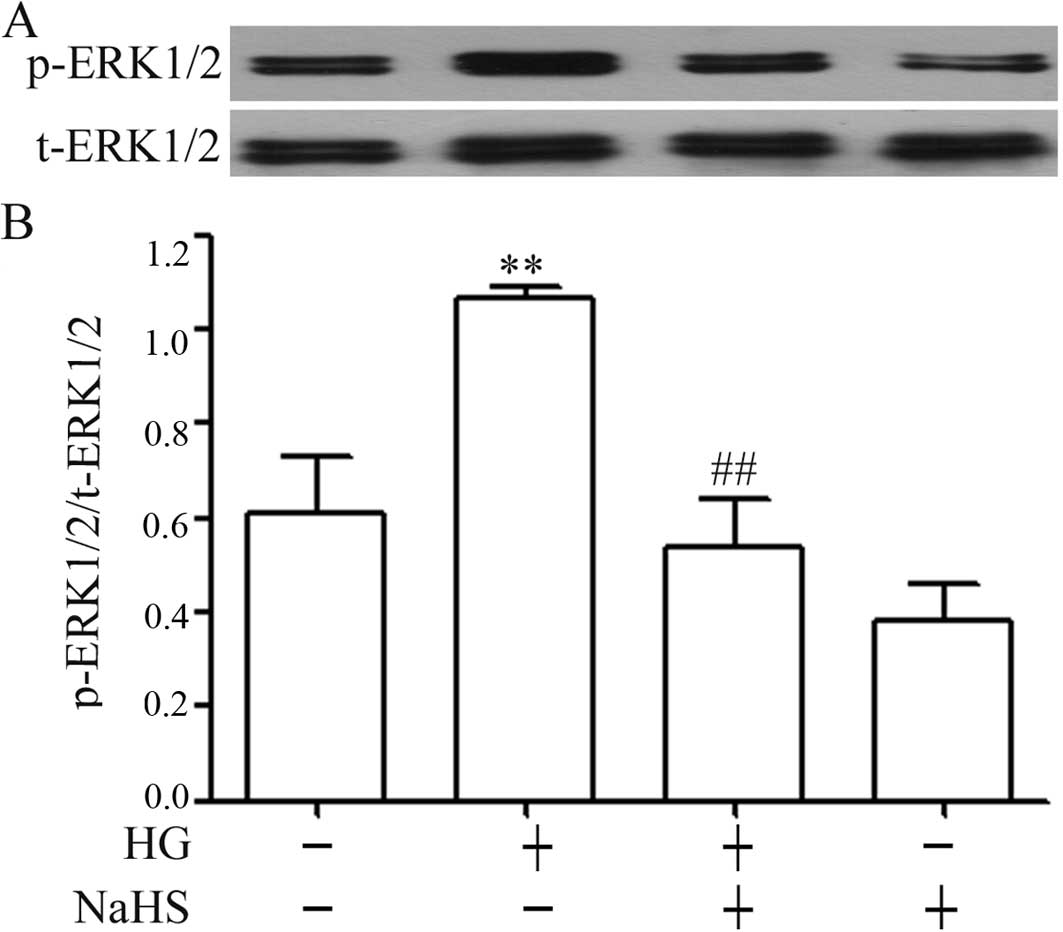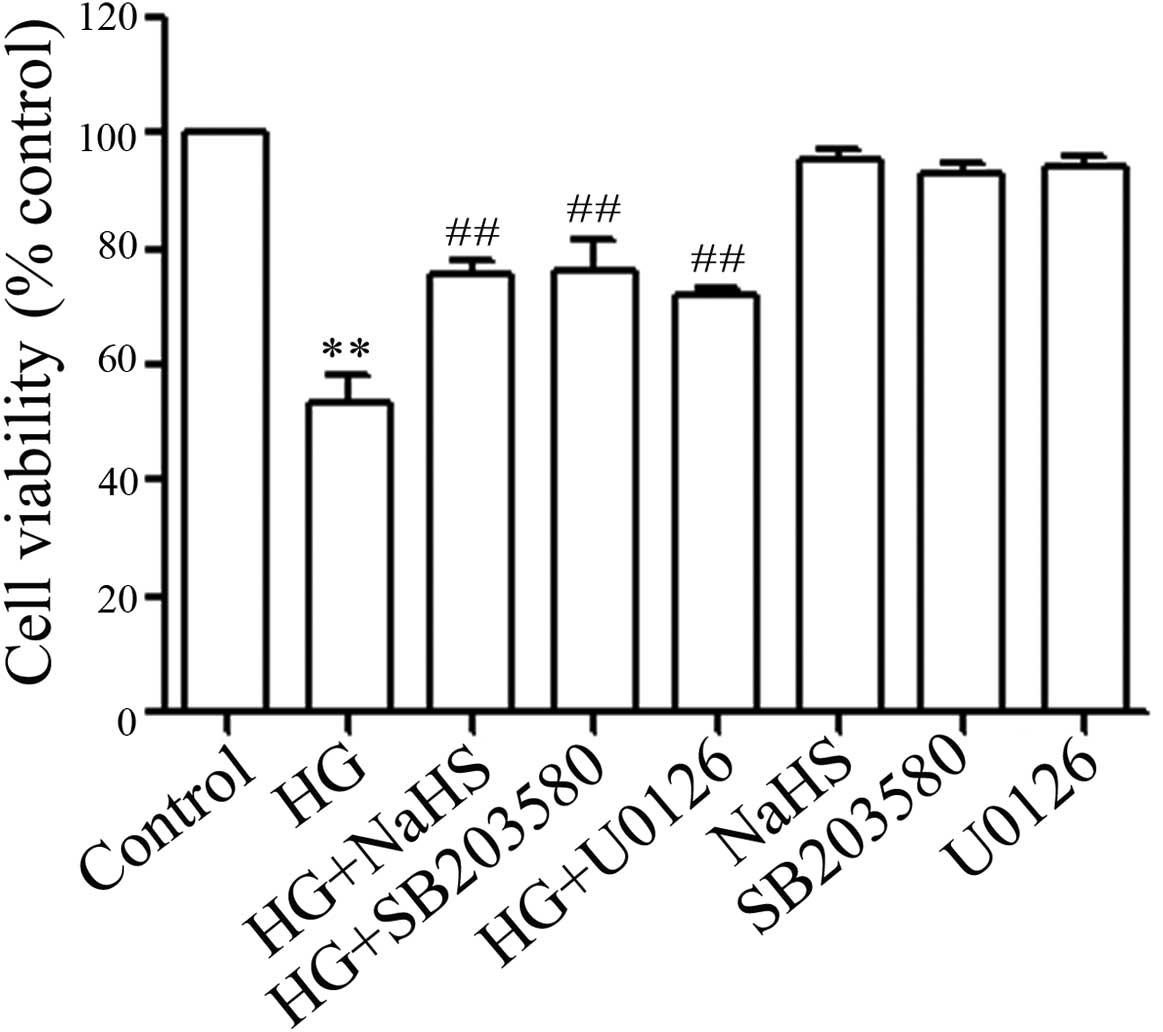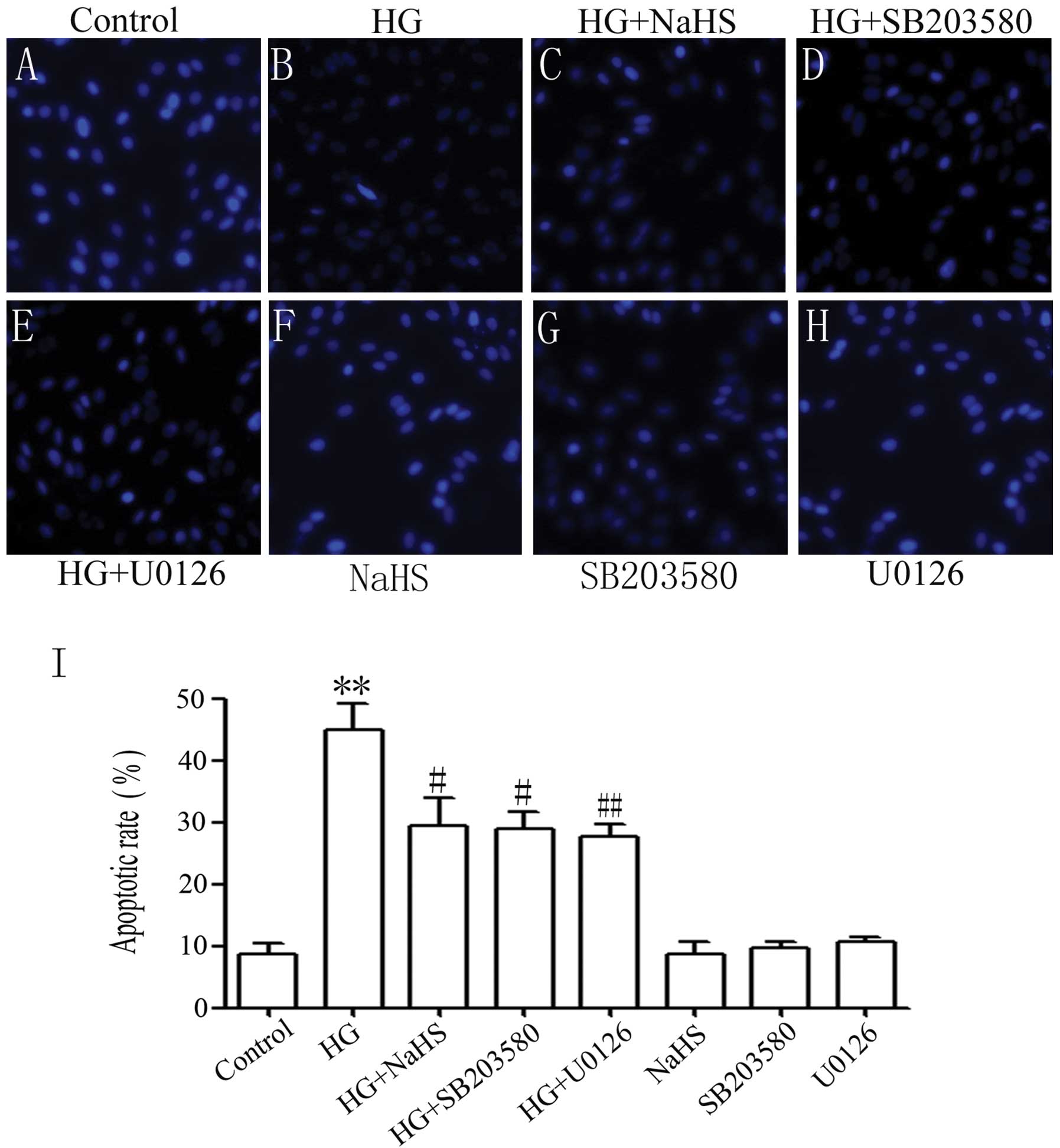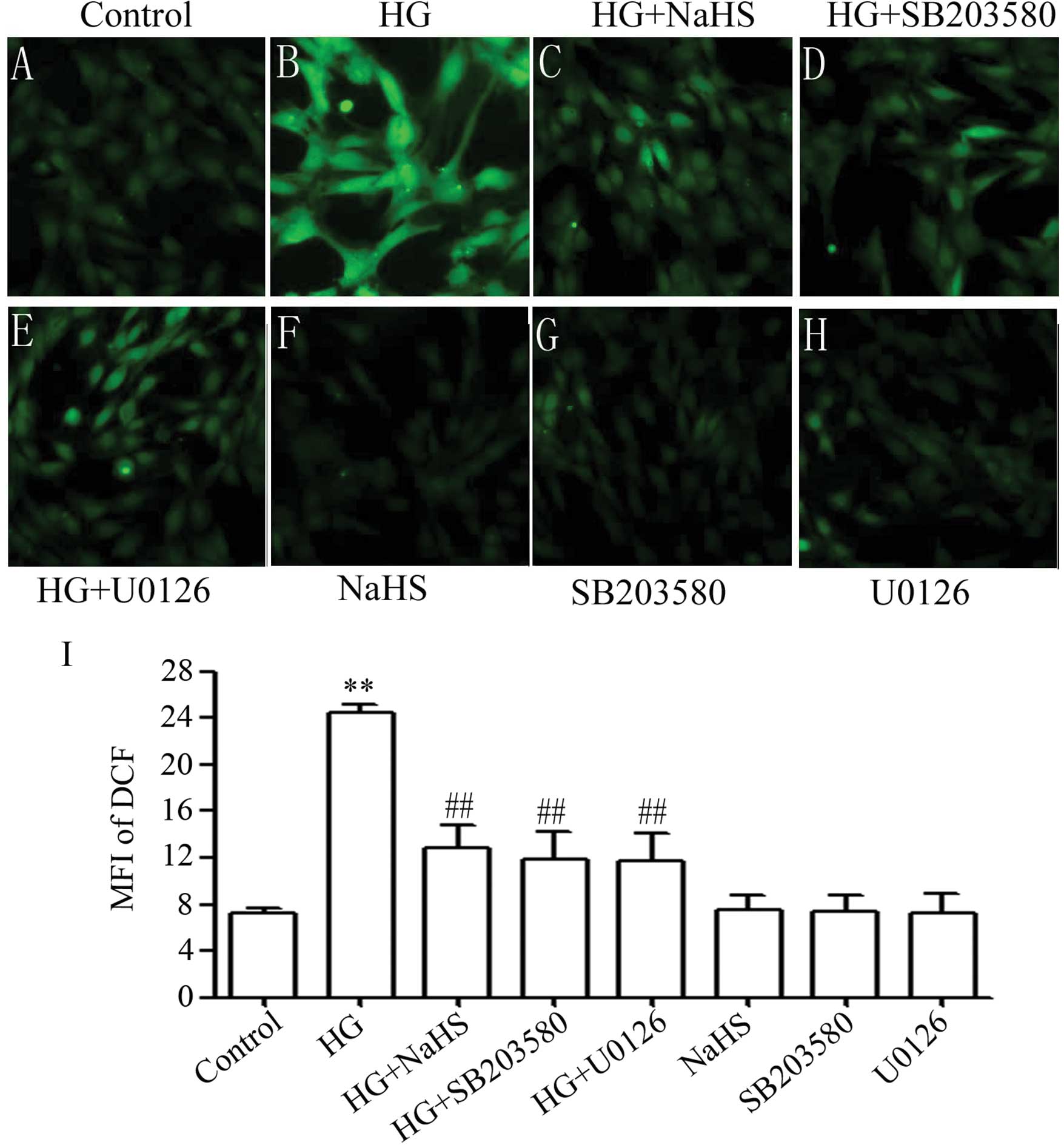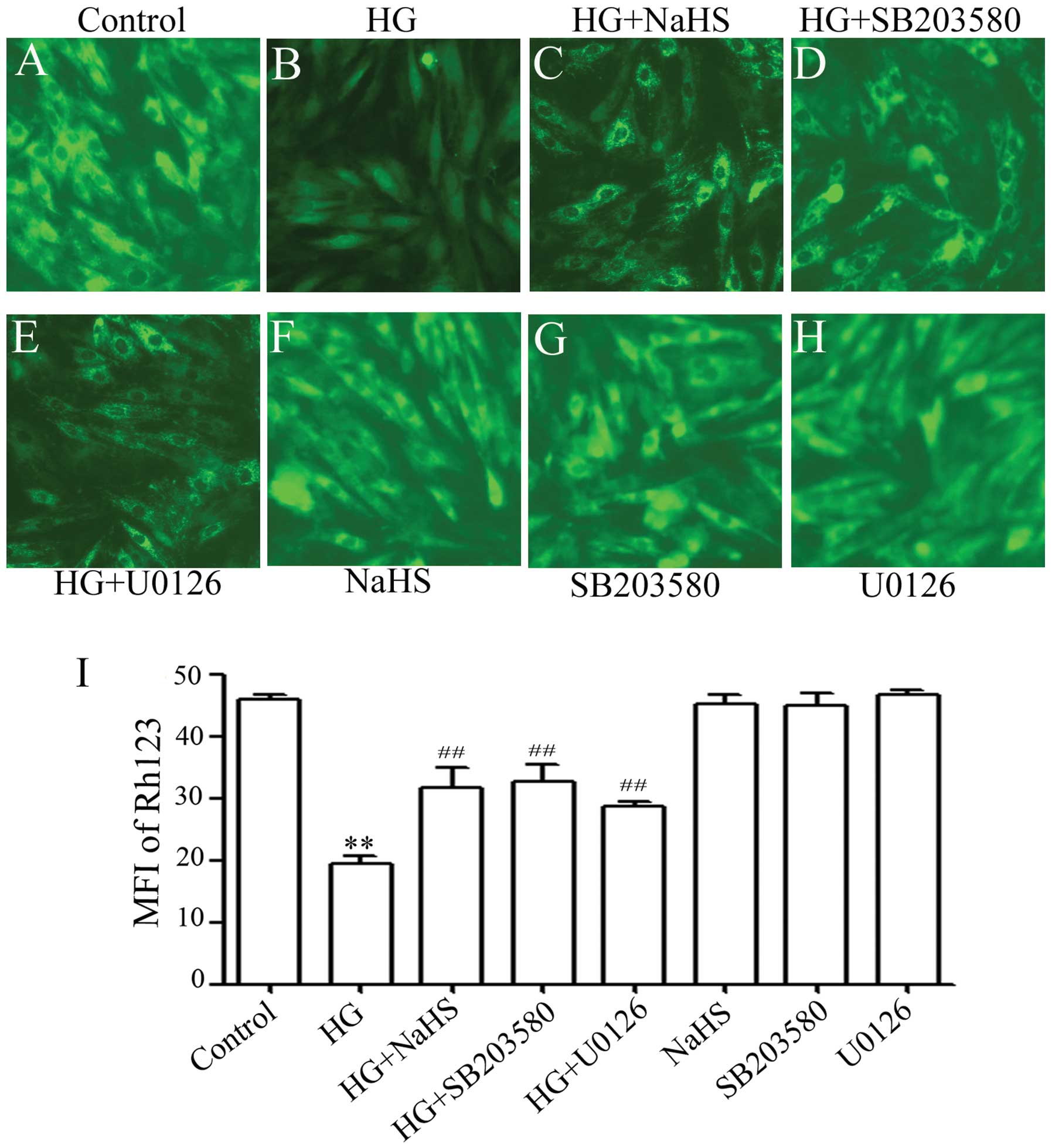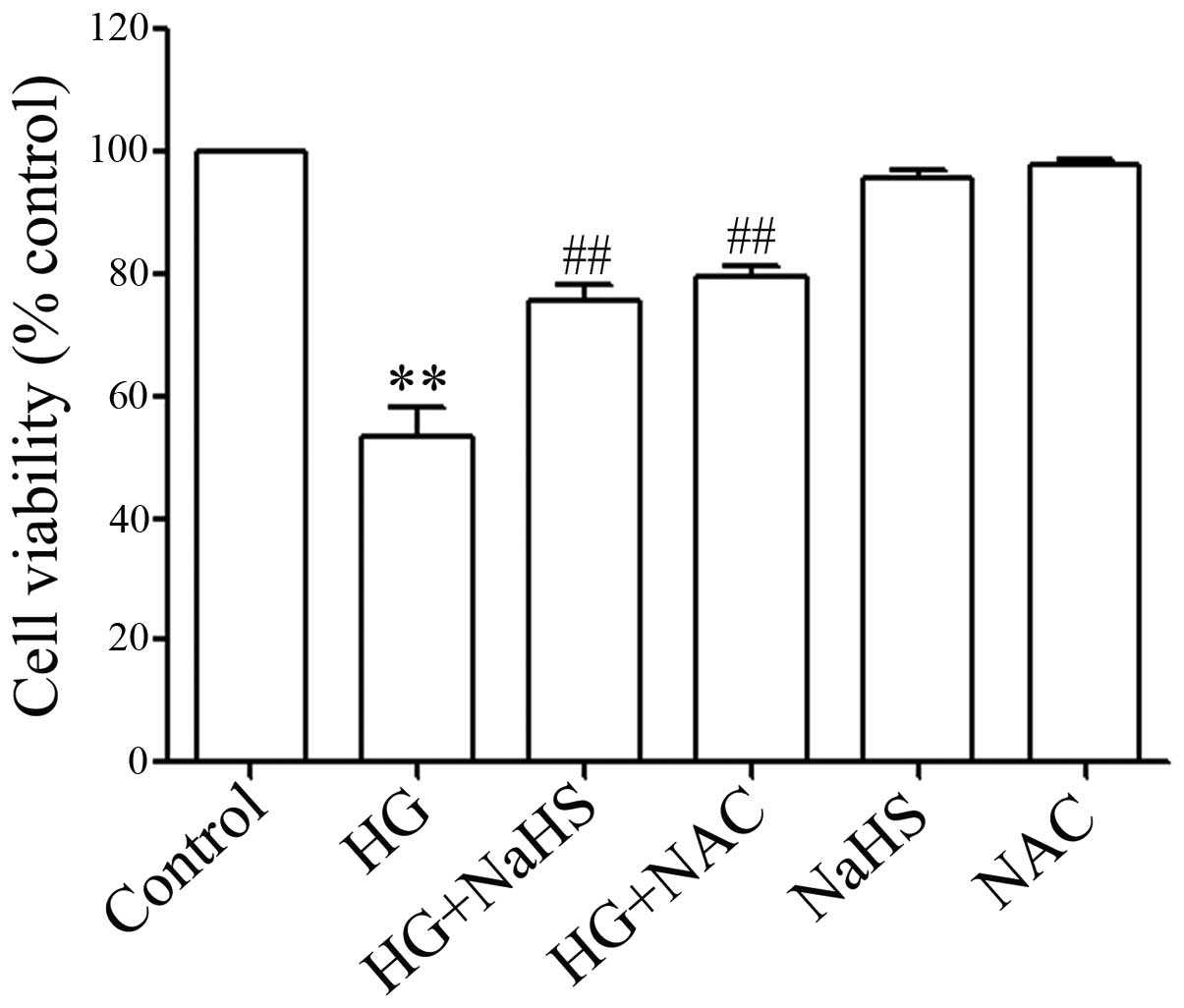Exogenous hydrogen sulfide protects H9c2 cardiac cells against high glucose-induced injury by inhibiting the activities of the p38 MAPK and ERK1/2 pathways
- Authors:
- Published online on: August 1, 2013 https://doi.org/10.3892/ijmm.2013.1462
- Pages: 917-925
Abstract
Introduction
Diabetic cardiomyopathy is characterized by phenotypic alterations in cardiac muscle, independent of micro- and macrovascular disease, coronary artery disease and hypertension (1–3). Several factors have been reported to be involved in the pathogenesis of this disease, including hyperglycemia, insulin resistance and oxidative stress-induced insults (3,4,5). Among these factors, hyperglycemia is considered one of the most important factors in the onset of diabetic cardiomyopathy (4,6). Thus, studies on the response of cardiac cells to acutely high levels of glucose may provide information for the prevention and treatment of the cumulative effects of high glucose (HG).
It is speculated that most of the effects of excessive glucose are associated with metabolism (7). An increase in glycolysis and hence, pyruvate, enhances the rate of oxidative phosphorylation, which results in reactive oxygen species (ROS) production. The increased ROS production contributes to oxidative stress, leading to myocardial damage (5,8,9). For this reason, curcumin, which has antioxidant effects, has been used to prevent diabetic cardiomyopathy in rats with streptozotocin (STZ)-induced diabetes (10). Accumulating evidence suggests that the activation of the mitogen-activated protein kinase (MAPK) signaling pathway attributes to the development of diabetic complications, including cardiac damage (10–13). Mammals express at least 3 distinct groups of MAPKs, including p38 MAPK, extracellular signal-regulated protein kinase 1/2 (ERK1/2) and c-Jun N-terminal kinase (JNK). MAPK signaling pathway is activated by HG stimulation in several types of cell model. Fang et al (14) demonstrated that the exposure of rat mesangial cells to HG (25 mM) significantly upregulated phosphorylated (p) expression levels of p38 MAPK and ERK1/2. The increased expression of p-p38 MAPK and p-ERK1/2 was inhibited by pre-treatment with N-acetyl-L-cysteine (NAC; a ROS scavenger), indicating the involvement of ROS in the HG-induced activation of p38 MAPK and ERK1/2 in rat mesangial cells (14). In STZ-induced diabetic rats, the expression levels of p-p38 MAPK and p-ERK1/2 are enhanced; curcumin has been shown to prevent diabetic cardiomyopathy by inhibiting the activation of p38 MAPK and ERK1/2 (10). Thus, it is reasonable to assume that molecules with antioxidant and inhibitory effects on MAPK activation may protect against HG-induced cardiomyocyte injury. One of these candidate molecules is hydrogen sulfide (H2S).
H2S, a well-known toxic gas with a characteristic smell of rotten eggs, has been qualified as the third gasotransmitter along with nitric oxide (NO) and carbon monoxide (CO) (15,16). H2S has been considered as an important cardioprotective agent. Exogenous H2S has been shown to reduce myocardial necrosis and rescue contractile activity in isoproterenol-treated rat hearts (17). Chronic H2S therapy improves survival and prevents ischemic-induced heart failure (18). In our previous studies, we demonstrated that exogenous H2S protects H9c2 cardiac cells against chemical hyoxia-induced injury by inhibiting oxidative stress and upregulating heat shock protein 90 (HSP90) expression (19,20). To date, the role of H2S in diabetes-induced cardiac damage has attracted considerable attention due to to its antioxidant (9,19–21) and modulatory effects on the signaling pathways, including MAPK pathways (22,23). Recently, H2S has been shown to provide protection against cardiomyopathy and vascular dysfunction in models of STZ-induced diabetes (24). In the diabetic db/db mouse heart model, Peake et al (9) demonstrated the protective effects of H2S against ischemic-reperfusion injury by activating nuclear factor (erythroid-derived 2)-like 2 (Nrf2) signaling. However, whether exogenous H2S protects cardiomyocytes against HG-induced injury by inhibiting p38 MAPK and ERK1/2 activation remains unclear. To examine this, in the present study, H9c2 cardiac cells were treated with 35 mM glucose (high glucose, HG) to establish a HG-induced cardiomyocyte injury model. We then focused on i) the effects of HG on the activation of p38 MAPK and ERK1/2; ii) the roles of the activation of p38 MAPK and ERK1/2 in HG-induced cardiomyocyte injury; iii) the effects of exogenous H2S on the HG-induced increase in p38 MAPK and ERK1/2 activation; iv) the roles of p38 MAPK and ERK1/2 activation in the protective effects of exogenous H2S against HG-induced injury in H9c2 cells. In the current study, to our knowledge, we provide the first evidence that exogenous H2S provides protection against HG-induced injury [including cytotoxicity, apoptosis and the loss of mitochondrial membrane potential (MMP)] by inhibiting the activation of p38 MAPK and ERK1/2 and preventing oxidative stress in H9c2 cells.
Materials and methods
Materials
Sodium hydrogen sulfide (NaHS), 2′,7′-dichlorofluorescein diacetate (DCFH-DA), Hoechst 33258 and NAC were purchased from Sigma-Aldrich (St. Louis, MO, USA). The Cell Counting Kit-8 (CCK-8) and rhodamine 123 (Rh123) were supplied by Dojindo Laboratories (Kumamoto, Japan). Anti-p-ERK1/2 antibody, anti-ERK1/2 antibody, anti-p38 antibody, anti-p-p38 antibody, U0126 and SB203580 were purchased from Cell Signaling Technology (Boston, MA, USA). Anti-β-actin antibody, horseradish peroxidase (HRP)-conjugated secondary antibody and the BCA Protein Assay kit were obtained from KangChen Bio-tech (Shanghai, China). Fetal bovine serum (FBS) and Dulbecco’s modified Eagle’s medium (DMEM)-F12 medium were obtained from Gibco BRL (Grand Island, NY, USA). The enhanced chemiluminescence (ECL) solution was purchased from KeyGen Biotech (Nanjing, China). The H9c2 cardiac cells were supplied by the Sun Yat-sen University Experimental Animal Center (Guangzhou, China).
H9c2 cell culture and treatments
The H9c2 cardiac cell line was acquired from the Sun Yat-sen University Experimental Animal Center. The cells were cultured in DMEM, supplemented with 10% FBS in a humidified atmosphere of 95% air and 5% CO2 at 37°C. The culture medium was replaced with fresh medium every 2–3 days and expanded to new culturewares when the cells reached approximately 80% confluency.
To explore the protective effects of H2S on HG-induced injury, the H9c2 cells were pre-conditioned with 400 μM NaHS for 30 min prior to exposure to HG for 24 h. To further determine whether the protective effects of NaHS were associated with the inhibition of p38 MAPK or ERK1/2 activity, the H9c2 cells were pre-conditioned with SB203580 (a selective inhibitor of p38 MAPK), or U0126 (a selective inhibitor of ERK1/2) 60 min prior to exposure to 35 mmol/l glucose for 24 h. To confirm whether the protective effects of NaHS were associated with its antioxidant action, H9c2 cells were pre-treated with NAC (a ROS scavenger).
Cell viability assay
The H9c2 cells in the logarithmic growth phase were cultured in plates at a concentration of 1×104 cells/ml. The CCK-8 assay was then employed to assess the viability of the H9c2 cardiac cells. After the indicated treatments, the cells were washed with PBS and 10 μl CCK-8 solution at a 10% dilution was added to each well and then the plate was incubated for approximately 90 min in an incubator. Absorbance at 450 nm was measured using a microplate reader (Molecular Devices, Sunnyvale, CA, USA). The means of the optical density (OD) of 3 wells in the indicated groups were used to calculate the percentage of cell viability according to the following formula: cell viability (%) = (ODtreatment group/ODcontrol group) ×100%. The experiment was repeated 5 times.
Hoechst 33258 nuclear staining for the assessment of apoptosis
Apoptotic cell death was assessed using the Hoechst 33258 staining method. The H9c2 cells were plated in 35-mm dishes at a density of 1×106 cells/well. At the end of the indicated treatments, the cells were harvested and fixed with paraformaldehyde in 0.1 mol/l PBS for 10 min. After rinsing with PBS, the nuclear DNA was stained with 5 mg/ml Hoechst 33258 dye for 10 min before being rinsed briefly with PBS and then visualized under a fluorescence microscope (Bx50-FLA; Olympus, Tokyo, Japan). Viable cells displayed a uniform blue fluorescence throughout the nucleus, whereas apoptotic cells showed fragmented and condensed nuclei. The experiment was repeated 3 times.
Measurement of MMP
MMP was assessed using a fluorescent dye, Rh123, a cell-permeable carionic dye that preferentially enters the mitochondria based on the highly negative MMP. The depolarization of MMP results in the loss of Rh123 from the mitochondria and a decrease in intracellular green fluorescence. H9c2 cardiac cells were cultured on a slide with Eagle’s minimal essential medium (EMEM)-F12. After the indicated treatments, the slides were washed 4 times with PBS. The H9c2 cells were incubated with 1 mg/l Rh123 at 37°C for 30 min in an incubator and washed briefly with PBS 4 times. Then Rh123 fluorescence was measured over the entire field of vision using a fluorescence microscope connected to an imaging system (BX50-FLA; Olympus). The mean fluorescence intensity (MFI) of Rh123 from 5 random fields was analyzed using ImageJ 1.41o software and was taken as an index of the levels of MMP. The experiment was carried out 5 times.
Western blot analysis
After being subjected to the indicated treatments, H9c2 cardiac cells were harvested and lysed with cell lysis solution. Total proteins in the cell lysates were quantified using the BCA Protein Assay kit. Loading buffer was added to the cytosolic extracts and after boiling for approximately 5 min, equal amounts of supernatant from each sample were fractionated by 10% sodium dodecyl sulphate-polyacrylamide gel electrophoresis (SDS-PAGE). Total proteins in the gel were transferred onto polyvinylidene difluoride (PVDF) membranes. The membranes were blocked for approximately 90 min at room temperature in fresh blocking buffer [0.1% Tween-20 in Tris-buffered saline (TBS-T) containing 5% milk] and then incubated with either anti-p38 (1:1,000 dilution), anti-p-p38 (1:1,000 dilution), anti-p-ERK1/2 (1:1,000 dilution) or anti-ERK1/2 (1:1,000 dilution) antibodies in freshly prepared TBS-T with 3% fat-free milk overnight with slow agitation at 4°C temperature. Following 3 washes with TBS-T, the membranes were incubated with HRP-conjugated goat anti-rabbit secondary antibody (1:2,500 dilution; KangChen Bio-tech) in TBS-T with 3% fat-free milk for 90 min at room temperature. The membranes were washed 3 times with TBS-T solution, developed in ECL solution and visualized using X-ray film. Each experiment was repeated 3 times. For quantification, the films were scanned and analyzed using ImageJ 1.47i software.
Measurement of intracellular ROS levels
The determination of intracellular ROS levels was performed by measuring a fluorescent product formed by the oxidation of DCFH-DA. Briefly, the culture medium was removed and the cells were washed with PBS 3 times. Following the addition of fresh culture medium, the cells were incubated with DCFH-DA at the final concentration of 10 μmol/l for 30 min at 37°C. The cells were then washed again with PBS 3 times and the relative amount of fluorescent product was assessed using a fluorescence microscope connected to an imaging system (BX50-FLA; Olympus). The MFI from 5 random fields was measured using ImageJ 1.41o software and the MFI was used as an index of the amount of ROS. The experiment was carried out 5 times.
Statistical analysis
All data are presented as the means ± SEM. Differences between groups were analyzed one-way analysis of variance (ANOVA) using SPSS 13.0 software (SPSS, Chicago, IL, USA) followed by the LSD post hoc comparison test. A P-value <0.05 was considered to indicate a statistically significant difference.
Results
Exogenous H2S inhibits the HG-induced upregulation of the expression of p-p38 MAPK in H9c2 cells
As illustrated in Fig. 1, treatment of the H9c2 cells with 35 mM glucose (HG) for 24 h significantly upregulated the expression of p-p38 MAPK in the H9c2 cells. However, this increase in the expression of p-p38 MAPK was attenuated by pre-treatment of the cells with 400 μM NaHS (a donor of H2S) for 30 min prior to exposure to HG. NaHS at 400 μM alone did not alter the basal expression of p-p38 MAPK in the H9c2 cells (Fig. 1).
Exogenous H2S attenuates the HG-induced increase in the expression of p-ERK1/2 in H9c2 cells
The results from western blot analysis revealed that the exposure of H9c2 cells to 35 mM glucose for 24 h markedly elevated the expression levels of p-ERK1/2 (Fig. 2), but did not induce significant changes in the expression of total (t)-ERK1/2. Additionally, similar to the inhibitory effects of NaHS on p-p38 MAPK expression, pre-treatment of the H9c2 cells with 400 μM NaHS for 30 min prior to exposure to 35 mM glucose markedly reduced the increased expression of p-ERK1/2 induced by HG for 24 h (Fig. 2). Alone, NaHS at 400 μM did not alter the basal expression of p-ERK1/2 in the H9c2 cells.
NaHS, p38 MAPK inhibitor and ERK1/2 inhibitor ameliorate HG-induced cytotoxicity in H9c2 cells
Firstly, we examined whether exogenous H2S protects H9c2 cells against HG-induced cytotoxicity. The H9c2 cells were pre-treated with 400 μM NaHS for 30 min followed by exposure to 35 mM glucose for 24 h. Our results revealed that pre-treatment with NaHS for 30 min significantly decreased HG-induced cytotoxicity, as evidenced by an increase in cell viability (Fig. 3). Since the above results (Figs. 1 and 2) showed that the expression levels of p-p38 MAPK and p-ERK1/2 were enhanced by HG treatment, we then wished to confirm whether p-p38 MAPK and p-ERK1/2 activation contributed to HG-induced cytotoxicity. As shown in Fig. 3, pre-treatment of the H9c2 cells with either 3 μM SB203580 (an inhibitor of p38 MAPK) or U0126 (a selective inhibitor of ERK1/2) for 60 min prior to exposure to 35 mM glucose markedly suppressed HG-induced cytotoxicity, leading to an increase in cell viability. These findings suggest that the activation of p38 MAPK and ERK1/2 is involved in HG-induced cytotoxicity.
NaHS, p38 MAPK inhibitor and ERK1/2 inhibitor diminish HG-induced apoptosis of H9c2 cells
We further explored the effects of exogenous H2S, p38 MAPK inhibitor and ERK1/2 inhibitor on HG-induced apoptosis. As shown in Fig. 4B, the exposure of the H9c2 cells to 35 mM glucose for 24 h induced characteristics typical of apoptosis, as evidenced by tbe condensation of chromatin, the shrinkage of nuclei and apoptotic bodies. Of note, pre-treatment of the cells with 400 μM NaHS for 30 min prior to HG exposure significantly attenuated the HG-induced increase in the number of cells with nuclear condensation and fragmentation (Fig. 4C). Similarly, pre-treatment of the cells with either 3 μM SB203580 or 15 μM U0126 for 60 min prior to HG treatment inhibited HG-induced apoptosis (Fig. 4D and E). Alone, NaHS, SB203580 or U0126 did not significantly affect cell morphology or the percentage of apoptotic H9c2 cells (Fig. 4F–H). The above results indicate that exogenous H2S protects H9c2 cells against HG-induced apoptosis which is associated, at least in part, with the activation of p38 MAPK and ERK1/2.
NaHS, p38 MAPK inhibitor and ERK1/2 inhibitor reduce HG-triggered oxidative stress in H9c2 cells
Accumulating evidence has indicated that the generation of ROS participates in HG-induced cardiac injury (25). Therefore, in this study, we observed the effects of exogenous H2S on HG-induced ROS generation in H9c2 cells. It was shown that treatment of the cells with 35 mM glucose for 24 h considerably increased the generation of ROS (Fig. 5B). The increased ROS generation was diminished by pre-treatment of the cells with 400 μM NaHS for 30 min prior to exposure to HG (Fig. 5C), illustrating the inhibitory effects of exogenous H2S on HG-induced oxidative stress. To investigate whether the activation of p38 MAPK and ERK1/2 is involved in HG-induced oxidative stress, the H9c2 cells were pre-treated with 3 μM SB203580 or 15 μM U0126 for 60 min prior to exposure to HG. As shown in Fig. 5, pre-treatment with SB203580 (Fig. 5D) or U0126 (Fig. 5E) markedly reduced the HG-induced increase in ROS generation, suggesting that the activation of p38 MAPK and ERK1/2 contributes to the overproduction of ROS induced by HG.
NaHS, p38 MAPK inhibitor and ERK1/2 inhibitor suppress the HG-induced dissipation of MMP in H9c2 cells
Previous studies have shown that ROS induces mitochondrial damage, which has been implicated in HG-induced cardiac insults (25). Thus, we explored whether exogenous H2S prevents the loss of MMP in HG-treated H9c2 cells. As shown in Fig. 6, treatment of the cells with 35 mM glucose for 24 h markedly induced mitochondrial damage, as evidenced by the dissipation of MMP (Fig. 6B). Importantly, the dissipation of MMP was ameliorated by pre-conditioning with 400 μM NaHS for 30 min prior to treatment of the cells with 35 mM glucose (Fig. 6C and I), suggesting the protective effects of exogenous H2S against the HG-induced loss of MMP. In addition, pre-treatment of the cells with either 3 μM SB203580 (Fig. 6D) or 15 μM U0126 (Fig. 6E) for 60 min prior to exposure to 35 mM glucose antagonized the HG-induced dissipation of MMP, indicating the involvement of the activation of p38 MAPK and ERK1/2 in HG-induced mitochondrial insults in H9c2 cells. Alone, NaHS at 400 μM or 3 μM SB203580 or 15 μM U0126 did not induce the loss of MMP (Fig. 6F–I).
ROS scavenger decreases the HG-induced cytotoxicity in H9c2 cells
In order to demonstrate whether the role of exogenous H2S (NaHS) in inhibiting HG-induced cytotoxicity is associated with its antioxidant effects, the H9c2 cells were pre-treated with 1,000 μM NAC (a ROS scavenger) for 60 min prior to esposure to 35 mM glucose for 24 h. Similar to the inhibitory effects of NaHS pre-treatment on HG-induced cytotoxicity, NAC pre-treatment significantly inhibited HG-induced cytotoxicity, resulting in an increase in cell viability (Fig. 7), revealing that the antioxidant effects of H2S contribute, at least in part, to the inhibitory effects of exogenous H2S on cytotoxicity induced by HG in the H9c2 cells.
Discussion
Increasing clinical studies have shown that hyperglycemia is a risk factor for the development of diabetic cardiomyopathy. However, the mechanisms responsible for HG-induced cardiac damage are not yet fully understood. Consistent with the data from previous studies (4,5,8–10), our results revealed that the exposure of H9c2 cardiac cells to 35 mM (HG) induced significant injury, as evidenced by a decrease in cell viability, an increase in the number of apoptotic cells and ROS production, as well as the dissipation of MMP. In order to clarify the correlation between the increased ROS levels and cytotoxicity, the H9c2 cells were pre-treated with NAC, a scavenger of ROS, prior to exposure to HG. The results of this study demonstrated that NAC pre-treatment markedly inhibited HG-induced cytotoxicity, leading to an increase in cell viability, suggesting the critical role of ROS in HG-elicited cardiomyocyte insults, which is supported by the results of previous studies (5,8–10).
Since the activation of p38 MAPK and ERK1/2 has been shown to contribute to the development of diabetic complications, such as diabetic nephropathy (14) and retinopathy (26), in this study, we first examined the effects of HG on the phosphorylation of p38 MAPK and ERK1/2 in H9c2 cells. Our results revealed that exposure of the cells to 35 mM glucose markedly enhanced the expression levels of p-p38 MAPK and p-ERK1/2, indicating the activation of p38 MAPK and ERK1/2 by HG. Similar to our results, p38 MAPK and ERK1/2 are activated in HG-induced human retinal pigmented epithelial cells (26). In addition, the chronic exposure of human mesangial cells to HG activates the p38 MAPK pathway (27). Our data are comparable with those of previous studies (26,27). Based on our findings, as well as those of previous studies (26,27), it can by hypothesized that HG may be an inducer of MAPK pathway activation.
Secondly, we investigated the roles of p38 MAPK and ERK1/2 in HG-induced cardiomyocyte injury. p38 MAPK and ERK1/2 are activated by cellular stress and have been reported to participate in cardiomycyte apoptosis and cardiac pathologies (28,29). The present study demonstrated that the pre-treatment of H9c2 cells with SB203580 (a selective inhibitor of p38 MAPK) markedly ameliorated HG-induced injury (including cytotoxicity, apoptosis, overproduction of ROS and the loss of MMP), as evidenced by an increase in cell viability and a decrease in the number of apoptotic cells and ROS production, as well as the attenuation of the dissipation of MMP. These results suggest that the activation of p38 MAPK contributes to HG-induced cytotoxicity, apoptosis and MMP loss, which may be an important mechanism underlying HG-triggered cardiac injury. Our findings support the notion that in the complex signaling events of apoptosis, the activation of p38 MAPK attenuates the mitochondrial function induced by changes in the ratio of pro-apoptotic (Bax) and anti-apoptotic (Bcl-2) members of the mitochondria, causing MMP loss, the release of cytochrome c and the activation of caspases, thus leading to apoptosis (30).
In addition, the role of ERK1/2 in HG-induced injury has gained much attention. The activation of ERK1/2 is stimulated by various stimuli and targets different downstream molecules, and therefore performs different functions. For example, the phosphorylation of ERK1/2/Akt in cardiomyocytes during early reperfusion has been found to serve as a defense mechanism against ischemia (31). Blockage with the ERK1/2-specific inhibitors, PD98059 and U0126, has been shown to inhibit ischemic pre-conditioning-induced cardioprotection (32). U0126 also attenuates the cardioprotective effects induced by fibroblast growth factor-1 (FGF-1) (33). However, the effects of ERK1/2 on cell survival are controversial, as the inhibition of ERK1/2 with U0126 and the downregulation of ERK1/2 using RNA interference has been shown to significantly reduce H2O2-induced apoptosis in neuronal cell lines (PC12 and SH-SY5Y cells) (34). In addition, the activation of the ERK1/2 pathway has been shown to be involved in chemical hypoxia-induced cardiomyocyte insults (23) and STZ-induced cardiac dysfunction (10). In accordance with these studies (10,23,34), in this study, we demonstrate that ERK1/2 activation contributes to HG-induced injury. This is supported by the following findings: i) HG upregulated the expression levels of p-ERK1/2 and ii) U0126 protected H9c2 cells against HG-induced injury, including cytotoxicity, apoptosis, ROS overproduction and the loss of MMP. These findings suggest that stimulating the activation of ERK1/2 may be another key mechanism responsible for HG-induced cardiomyocyte insults.
Importantly, in this study, we demonstrate the potential protective effects of H2S in HG-treated H9c2 cardiac cells. H2S has been considered as a novel gasomolecule with cardioprotective effects. H2S is produced enzymatically in mammalian species via the action of 3 enzymes in the cysteine biosynthesis pathway: cystathionine-γ-lyase (CSE), cystathionine-β-synthase (CBS) and 3-mercaptopyruvate sulfurtransferase (3-MST). Changes in H2S levels in diabetes have attracted attention. There is clear evidence that circulating levels of H2S are reduced in animal models of diabetes (24,35–37). Notably, lower circulating H2S levels have been measured in plasma samples obtained from patients with type 2 diabetes mellitus (T2DM) (35,38). These findings have promoted researchers to explore the protective effects of exogenous H2S against diabetes-induced cardiac injury. Increasing evidence shows that exogenous H2S exerts protective effects against several models of myocardial injury in the setting of type 1 diabetes by preventing apoptosis and oxidative stress (24,39). In db/db mice, H2S therapy in the form of NaHS has been shown to attenuate myocardial ischemia-reperfusion injury (9). In agreement with these studies (9,24,39), we found that exogenous H2S exerted multiple protective effects, including anticytotoxic, anti-apoptotic and antioxidant effects, as well as mitochondrial protective effects (alleviating the loss of MMP), against HG-induced injury in H9c2 cells. One of the mechanisms underlying these protective effects may be associated the antioxidant effects of H2S (lowering ROS production), as NAC, a ROS scavenger, exerted protective effects similar to those of H2S against HG-induced cytotoxicity.
Since we have previously demonstrated the inhibitory effects of exogenous H2S on the chemical hypoxia-induced activation of p38 MAPK and ERK1/2 in PC12 cells (22) and the activation of ERK1/2 in H9c2 cells (23), in this study, we explored the modulatory effects of exogenous H2S on the HG-stimulated activation of p38 MAPK and ERK1/2 in H9c2 cells. We found that pre-treatment of the H9c2 cells with NaHS attenuated not only the expression level of p-p38 MAPK, but also that of p-ERK1/2 induced by HG in H9c2 cells, revealing that exogenous H2S inhibits the HG-induced activation of p38 MAPK and ERK1/2, which may be one of important mechanisms responsible for the cardioprotective effects of exogenous H2S against HG-induced injury in H9c2 cells. The involvement of hte inhibition of the p38 MAPK pathway in the cytoprotective effects of exogenous H2S has also been reported by other studies. Hu et al indicated that H2S suppresses LPS-induced inflammation by inhibiting p38 MAPK in microglia (40) and that H2S protects SH-SY5Y cells against rotenone-induced apoptosis through the suppression of p38 MAPK activation (41). Additionally, exogenous H2S reduces doxorubicin-induced cardiotoxicity by inhibiting the activation of the p38 MAPK pathway (29). Our results, as well as those from previous studies (22,29,40,41) suggest that exogenous H2S may be a potential inhibitor of p38 MAPK.
However, reports on the effects of H2S on the activation of ERK1/2 are controversial. The ERK1/2 activation has been shown to be increased (42–46), decreased (22,23,29,47–49) or unaltered (50,51) following exposure to H2S. In the present study, we provide clear evidence that the activation of ERK1/2 contributes to HG-induced injury in H9c2 cells and that exogenous H2S protects H9c2 cells against HG-induced injury by inhibiting ERK1/2 activation, which is supported by our previous study [Dong et al (23)]. Although the mechanisms through which ERK1/2 induces either cell death or survival and the reasons for the differential effects induced by exogenous H2S on the activation of ERK1/2 are unclear, it is generally accepted that the duration and magnitude of ERK1/2 activation may be an important factor in determining cell survival or apoptosis (52). In addition, exploring the interaction between ERK1/2 and survival or apoptotic regulators may provide important information on the mechanisms underlying the differential effects of exogenous H2S on ERK1/2 activation.
In conclusion, to our knowledge, the findings of present study demonstrate for the first time that exogenous H2S protects against HG-induced injury by attenuating the activation of p38 MAPK and ERK1/2 in H9c2 cardiac cells. Our results also provide important evidence that the activation of p38 MAPK and ERK1/2 is involved in HG-induced multiple cardiomyocyte injury, including cytotoxicity, apoptosis, ROS overproduction and the dissipation of MMP. These findings may provide a rationale for designing effective therapeutic strategies for the treatment of heart disease in the setting of diabetes.
Acknowledgements
The present study was supported by grants from the Science and Technology Planning Project of Guangdong of China (2010B080701035, 2010B080701105 and 2012B031800358) and the National Natural Science Foundation of China (H0208).
References
|
Grundy SM, Benjamin IJ, Burke GL, et al: Diabetes and cardiovascular disease: a statement for healthcare professionals from the American Heart Association. Circulation. 100:1134–1146. 1999. View Article : Google Scholar : PubMed/NCBI | |
|
Cai L and Kang YJ: Oxidative stress and diabetic cardiomyopathy: a brief review. Cardiovasc Toxicol. 1:181–193. 2001. View Article : Google Scholar : PubMed/NCBI | |
|
Francis GS: Diabetic cardiomyopathy: fact or fiction? Heart. 85:247–248. 2001. View Article : Google Scholar : PubMed/NCBI | |
|
Rodrigues B, Cam MC and McNeill JH: Metabolic disturbances in diabetic cardiomyopathy. Mol Cell Biochem. 180:53–57. 1998. View Article : Google Scholar : PubMed/NCBI | |
|
Privratsky JR, Wold LE, Sowers JR, Quinn MT and Ren J: AT1 blockade prevents glucose-induced cardiac dysfunction in ventricular myocytes: role of the AT1 receptor and NADPH oxidase. Hypertension. 42:206–212. 2003. View Article : Google Scholar : PubMed/NCBI | |
|
Ren J and Davidoff AJ: Diabetes rapidly induces contractile dysfunctions in isolated ventricular myocytes. Am J Physiol. 272:H148–H158. 1997.PubMed/NCBI | |
|
Rahimi R, Nikfar S, Larijani B and Abdollahi M: A review on the role of antioxidants in the management of diabetes and its complications. Biomed Pharmacother. 59:365–373. 2005. View Article : Google Scholar : PubMed/NCBI | |
|
Cai H and Harrison DG: Endothelial dysfunction in cardiovascular diseases: the role of oxidant stress. Circ Res. 87:840–844. 2000. View Article : Google Scholar : PubMed/NCBI | |
|
Peake BF, Nicholson CK, Lambert JP, et al: Hydrogen sulfide preconditions the db/db diabetic mouse heart against ischemia-reperfusion injury by activating Nrf2 signaling in an Erk-dependent manner. Am J Physiol Heart Circ Physiol. 304:H1215–H1224. 2013. View Article : Google Scholar | |
|
Soetikno V, Sari FR, Sukumaran V, et al: Curcumin prevents diabetic cardiomyopathy in streptozotocin-induced diabetic rats: possible involvement of PKC-MAPK signaling pathway. Eur J Pharm Sci. 47:604–614. 2012. View Article : Google Scholar : PubMed/NCBI | |
|
Evans JL, Goldfine ID, Maddux BA and Grodsky GM: Oxidative stress and stress-activated signaling pathways: a unifying hypothesis of type 2 diabetes. Endocr Rev. 23:599–622. 2002. View Article : Google Scholar : PubMed/NCBI | |
|
Igarashi M, Wakasaki H, Takahara N, et al: Glucose or diabetes activates p38 mitogen-activated protein kinase via different pathways. J Clin Invest. 103:185–195. 1999. View Article : Google Scholar : PubMed/NCBI | |
|
Yan J, Young ME, Cui L, Lopaschuk GD, Liao R and Tian R: Increased glucose uptake and oxidation in mouse hearts prevent high fatty acid oxidation but cause cardiac dysfunction in diet-induced obesity. Circulation. 119:2818–2828. 2009. View Article : Google Scholar | |
|
Fang S, Jin Y, Zheng H, et al: High glucose condition upregulated Txnip expression level in rat mesangial cells through ROS/MEK/MAPK pathway. Mol Cell Biochem. 347:175–182. 2011. View Article : Google Scholar : PubMed/NCBI | |
|
Łowicka E and Bełtowski J: Hydrogen sulfide (H2S) - the third gas of interest for pharmacologists. Pharmacol Rep. 59:4–24. 2007. | |
|
Moore PK, Bhatia M and Moochhala S: Hydrogen sulfide: from the smell of the past to the mediator of the future? Trends Pharmacol Sci. 24:609–611. 2003. View Article : Google Scholar : PubMed/NCBI | |
|
Geng B, Chang L, Pan C, et al: Endogenous hydrogen sulfide regulation of myocardial injury induced by isoproterenol. Biochem Biophys Res Commun. 318:756–763. 2004. View Article : Google Scholar : PubMed/NCBI | |
|
Calvert JW, Jha S, Gundewar S, et al: Hydrogen sulfide mediates cardioprotection through Nrf2 signaling. Circ Res. 105:365–374. 2009. View Article : Google Scholar : PubMed/NCBI | |
|
Chen SL, Yang CT, Yang ZL, et al: Hydrogen sulphide protects H9c2 cells against chemical hypoxia-induced injury. Clin Exp Pharmacol Physiol. 37:316–321. 2010. View Article : Google Scholar : PubMed/NCBI | |
|
Yang Z, Yang C, Xiao L, et al: Novel insights into the role of HSP90 in cytoprotection of H2S against chemical hypoxia-induced injury in H9c2 cardiac myocytes. Int J Mol Med. 28:397–403. 2011.PubMed/NCBI | |
|
Nicholson CK and Calvert JW: Hydrogen sulfide and ischemia-reperfusion injury. Pharmacol Res. 62:289–297. 2010. View Article : Google Scholar : PubMed/NCBI | |
|
Lan A, Liao X, Mo L, et al: Hydrogen sulfide protects against chemical hypoxia-induced injury by inhibiting ROS-activated ERK1/2 and p38MAPK signaling pathways in PC12 cells. PLoS One. 6:e259212011. View Article : Google Scholar : PubMed/NCBI | |
|
Dong XB, Yang CT, Zheng DD, et al: Inhibition of ROS-activated ERK1/2 pathway contributes to the protection of H2S against chemical hypoxia-induced injury in H9c2 cells. Mol Cell Biochem. 362:149–157. 2012. View Article : Google Scholar : PubMed/NCBI | |
|
Suzuki K, Olah G, Modis K, et al: Hydrogen sulfide replacement therapy protects the vascular endothelium in hyperglycemia by preserving mitochondrial function. Proc Natl Acad Sci USA. 108:13829–13834. 2011. View Article : Google Scholar | |
|
Malhotra A, Vashistha H, Yadav VS, et al: Inhibition of p66ShcA redox activity in cardiac muscle cells attenuates hyperglycemia-induced oxidative stress and apoptosis. Am J Physiol Heart Circ Physiol. 296:H380–H388. 2009. View Article : Google Scholar | |
|
Yuan Z, Feng W, Hong J, Zheng Q, Shuai J and Ge Y: p38MAPK and ERK promote nitric oxide production in cultured human retinal pigmented epithelial cells induced by high concentration glucose. Nitric Oxide. 20:9–15. 2009. View Article : Google Scholar | |
|
Wilmer WA, Dixon CL and Hebert C: Chronic exposure of human mesangial cells to high glucose environments activates the p38 MAPK pathway. Kidney Int. 60:858–871. 2001. View Article : Google Scholar : PubMed/NCBI | |
|
Sugden PH and Clerk A: ‘Stress-responsive’ mitogen-activated protein kinases (c-Jun N-terminal kinases and p38 mitogen-activated protein kinases) in the myocardium. Circ Res. 83:345–352. 1998. | |
|
Guo R, Lin J, Xu W, et al: Hydrogen sulfide attenuates doxorubicin-induced cardiotoxicity by inhibition of the p38 MAPK pathway in H9c2 cells. Int J Mol Med. 31:644–650. 2013.PubMed/NCBI | |
|
Yang J, Liu X, Bhalla K, et al: Prevention of apoptosis by Bcl-2: release of cytochrome c from mitochondria blocked. Science. 275:1129–1132. 1997. View Article : Google Scholar : PubMed/NCBI | |
|
Yue TL, Wang C, Gu JL, et al: Inhibition of extracellular signal-regulated kinase enhances Ischemia/Reoxygenation-induced apoptosis in cultured cardiac myocytes and exaggerates reperfusion injury in isolated perfused heart. Circ Res. 86:692–699. 2000. View Article : Google Scholar | |
|
Strohm C, Barancik T, Brühl ML, Kilian SA and Schaper W: Inhibition of the ER-kinase cascade by PD98059 and UO126 counteracts ischemic preconditioning in pig myocardium. J Cardiovasc Pharmacol. 36:218–229. 2000. View Article : Google Scholar : PubMed/NCBI | |
|
Buehler A, Martire A, Strohm C, et al: Angiogenesis-independent cardioprotection in FGF-1 transgenic mice. Cardiovasc Res. 55:768–777. 2002. View Article : Google Scholar : PubMed/NCBI | |
|
Chen L, Liu L, Yin J, Luo Y and Huang S: Hydrogen peroxide-induced neuronal apoptosis is associated with inhibition of protein phosphatase 2A and 5, leading to activation of MAPK pathway. Int J Biochem Cell Biol. 41:1284–1295. 2009. View Article : Google Scholar : PubMed/NCBI | |
|
Jain SK, Bull R, Rains JL, et al: Low levels of hydrogen sulfide in the blood of diabetes patients and streptozotocin-treated rats causes vascular inflammation? Antioxid Redox Signal. 12:1333–1337. 2010. View Article : Google Scholar : PubMed/NCBI | |
|
Yusuf M, Kwong Huat BT, Hsu A, Whiteman M, Bhatia M and Moore PK: Streptozotocin-induced diabetes in the rat is associated with enhanced tissue hydrogen sulfide biosynthesis. Biochem Biophys Res Commun. 333:1146–1152. 2005. View Article : Google Scholar : PubMed/NCBI | |
|
Ahmad FU, Sattar MA, Rathore HA, et al: Exogenous hydrogen sulfide (H2S) reduces blood pressure and prevents the progression of diabetic nephropathy in spontaneously hypertensive rats. Ren Fail. 34:203–210. 2012.PubMed/NCBI | |
|
Whiteman M, Gooding KM, Whatmore JL, et al: Adiposity is a major determinant of plasma levels of the novel vasodilator hydrogen sulphide. Diabetologia. 53:1722–1726. 2010. View Article : Google Scholar : PubMed/NCBI | |
|
Gao Y, Yao X, Zhang Y, et al: The protective role of hydrogen sulfide in myocardial ischemia-reperfusion-induced injury in diabetic rats. Int J Cardiol. 152:177–183. 2011. View Article : Google Scholar : PubMed/NCBI | |
|
Hu LF, Wong PT, Moore PK and Bian JS: Hydrogen sulfide attenuates lipopolysaccharide-induced inflammation by inhibition of p38 mitogen-activated protein kinase in microglia. J Neurochem. 100:1121–1128. 2007. View Article : Google Scholar | |
|
Hu LF, Lu M, Wu ZY, Wong PT and Bian JS: Hydrogen sulfide inhibits rotenone-induced apoptosis via preservation of mitochondrial function. Mol Pharmacol. 75:27–34. 2009. View Article : Google Scholar : PubMed/NCBI | |
|
Adhikari S and Bhatia M: H2S-induced pancreatic acinar cell apoptosis is mediated via JNK and p38 MAP kinase. J Cell Mol Med. 12:1374–1383. 2008. | |
|
Zhi L, Ang AD, Zhang H, Moore PK and Bhatia M: Hydrogen sulfide induces the synthesis of proinflammatory cytokines in human monocyte cell line U937 via the ERK-NF-kappaB pathway. J Leukoc Biol. 81:1322–1332. 2007. View Article : Google Scholar : PubMed/NCBI | |
|
Mukherjee S, Lekli I, Goswami S and Das DK: Freshly crushed garlic is a superior cardioprotective agent than processed garlic. J Agric Food Chem. 57:7137–7144. 2009. View Article : Google Scholar : PubMed/NCBI | |
|
Hu Y, Chen X, Pan TT, et al: Cardioprotection induced by hydrogen sulfide preconditioning involves activation of ERK and PI3K/Akt pathways. Pflugers Arch. 455:607–616. 2008. View Article : Google Scholar : PubMed/NCBI | |
|
Yang G, Wu L, Bryan S, Khaper N, Mani S and Wang R: Cystathionine gamma-lyase deficiency and overproliferation of smooth muscle cells. Cardiovasc Res. 86:487–495. 2010. View Article : Google Scholar : PubMed/NCBI | |
|
Yang G, Yang W, Wu L and Wang R: H2S, endoplasmic reticulum stress, and apoptosis of insulin-secreting beta cells. J Biol Chem. 282:16567–16576. 2007.PubMed/NCBI | |
|
Lu M, Hu LF, Hu G and Bian JS: Hydrogen sulfide protects astrocytes against H(2)O(2)-induced neural injury via enhancing glutamate uptake. Free Radic Biol Med. 45:1705–1713. 2008. View Article : Google Scholar : PubMed/NCBI | |
|
Kloesch B, Liszt M and Broell J: H2S transiently blocks IL-6 expression in rheumatoid arthritic fibroblast-like synoviocytes and deactivates p44/42 mitogen-activated protein kinase. Cell Biol Int. 34:477–484. 2010. | |
|
Cai WJ, Wang MJ, Moore PK, Jin HM, Yao T and Zhu YC: The novel proangiogenic effect of hydrogen sulfide is dependent on Akt phosphorylation. Cardiovasc Res. 76:29–40. 2007. View Article : Google Scholar : PubMed/NCBI | |
|
Bliksøen M, Kaljusto ML, Vaage J and Stensløkken KO: Effects of hydrogen sulphide on ischaemia-reperfusion injury and ischaemic preconditioning in the isolated, perfused rat heart. Eur J Cardiothorac Surg. 34:344–349. 2008.PubMed/NCBI | |
|
Marshall CJ: Specificity of receptor tyrosine kinase signaling: transient versus sustained extracellular signal-regulated kinase activation. Cell. 80:179–185. 1995. View Article : Google Scholar |



